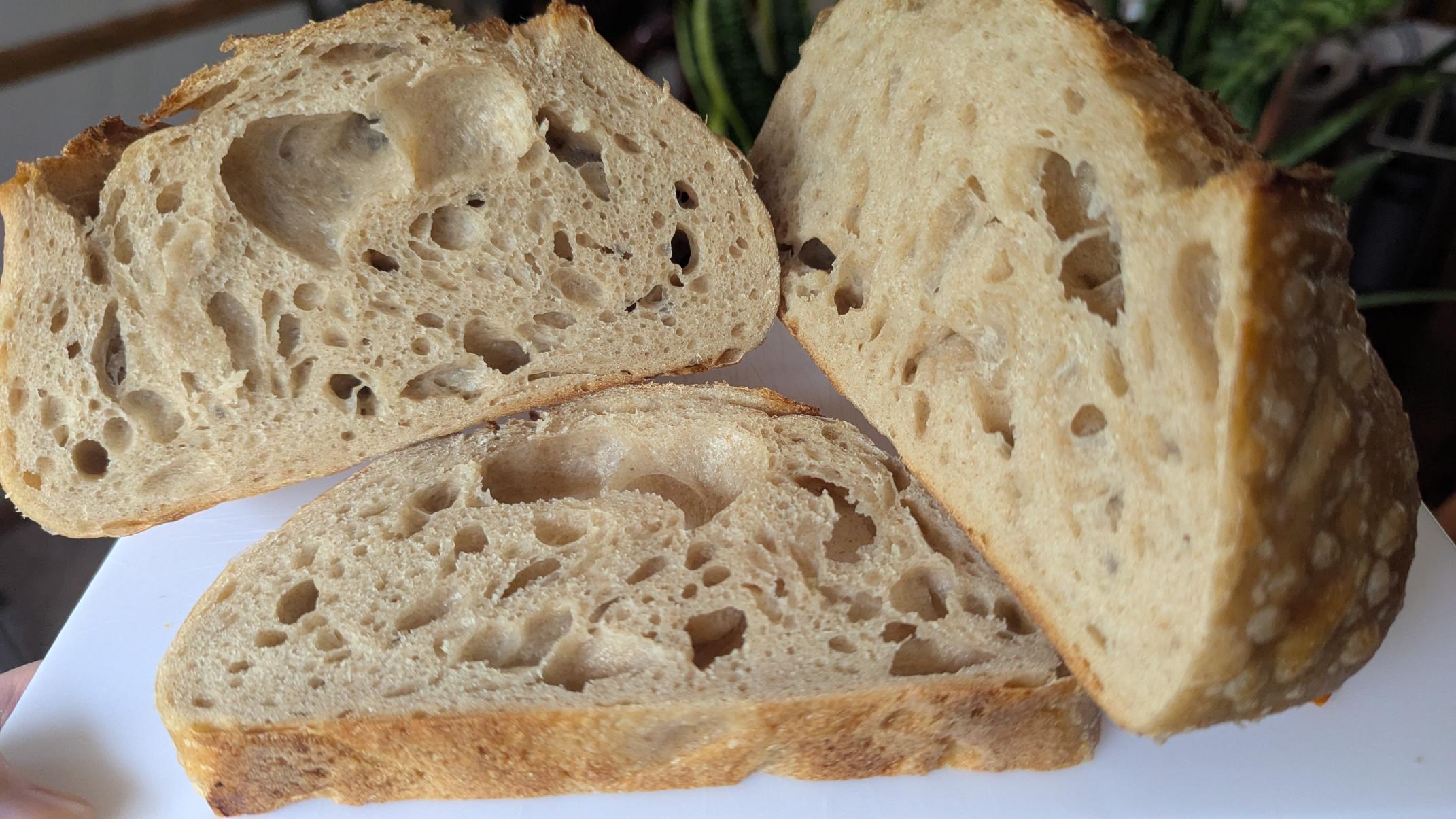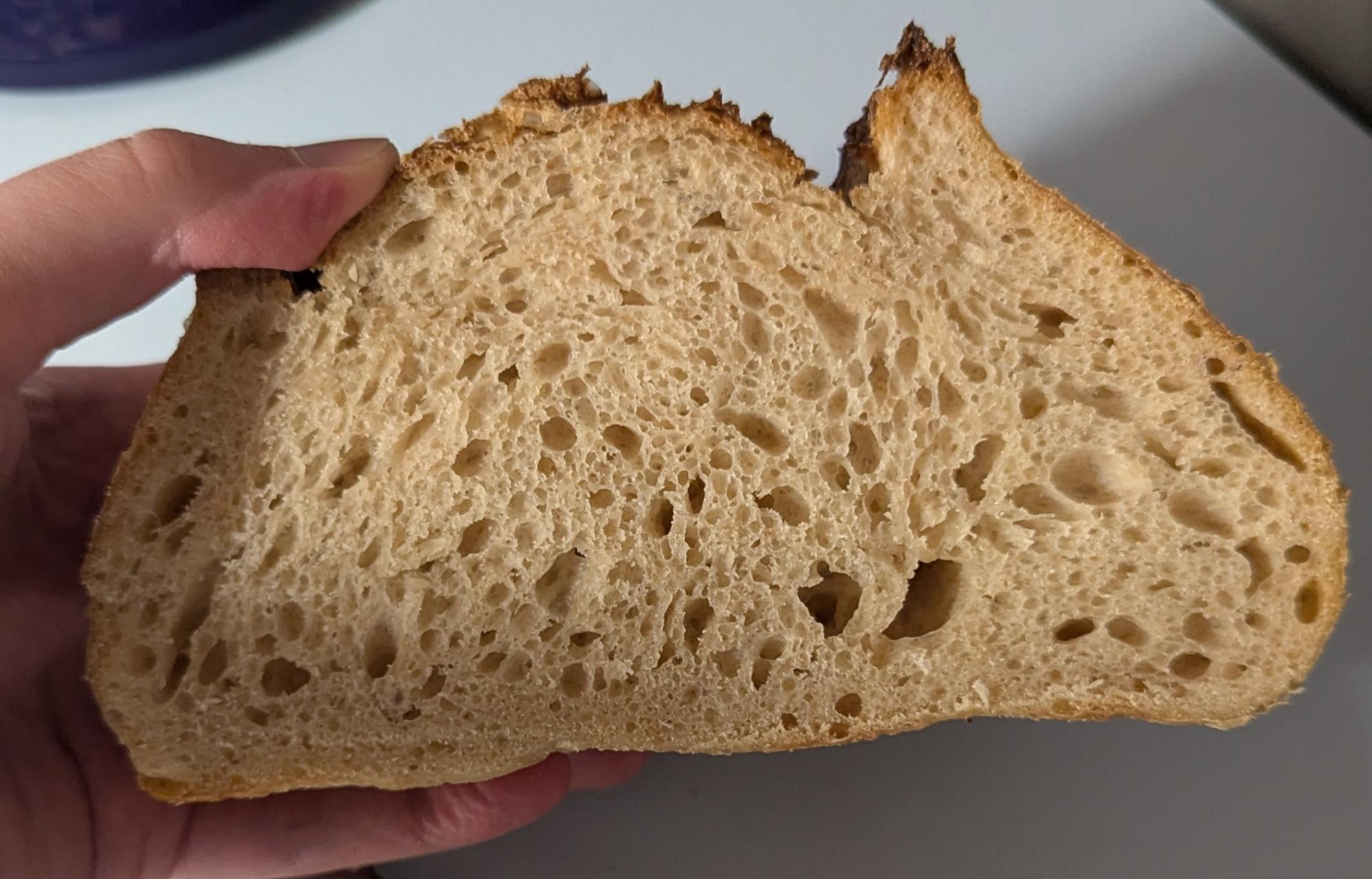I am practicing with my new Rofco B40 oven before the farmer's market season starts in my area. Last year I baked in my home oven and got really good consistent results, so I am having to adjust in order to get my bread the way I want with this new oven and the weather being different right now. Could I get some help reading my crumb and making adjustments?
Yesterday's loaf (try #3 in oven):

Shaping issue, proofing issue, starter issue, scoring issue or a combo? Want a more even crumb (picture below) but this loaf seems like it's got larger holes. Taste and texture is overall where I want it. Overall it seems underproved or I didn't shape well and incorporated some bubbles.
Recipe:
75% bread flour
25% whole wheat flour (mix of rye, red fife, and spelt)
75% hydration
2% salt
20% starter
Mixed then fermentolyse for 45mins. Added salt and then coil folded 4x over the next 2-3 hours. Total time from mix to shaping and in the fridge was about 7-8 hours. Dough was at 73-75 degrees F and got to about 50-60% rise. Preshaped into a boule and final shaped into a batard by doing an envelope fold and then rolling up. I do slap the dough after doing the envelope fold to knock some of the larger bubbles out. I use a stiff starter that is regularly fed.
What I am trying to achieve (didn't record my process for this batch sadly):

Any help or advice is much appreciated! Thank you!
Work on shaping - work on proofing - starter is fine if you know how it reacts - scoring doesn't matter. What you want is a matter of getting what you want in the time frame given. Working on it is your best bet. Enjoy!
Looking at the crumb the dough was under fermented. Relatively dense crumb with large alveoli particularly in the upper half of the crumb. So it could be a combination of your starter/levain not being active enough, too short bulk and finally too short final proof. That being said, it isn't terribly short on fermentation, but you could get what you're aiming for getting the dough a bit warmer and fermenting longer.
Benny
could use more bottom heat. You may need a longer pre heat time with this oven.
Don
I would try increasing both bulk ferment and final proofing. Go from 50 - 60% rise in bulk up to 100%, for example. This should reduce the forcefulness of the rise when the loaf goes into the oven. You could also be more firm during shaping, to try to seal all the dough surfaces to each other better in the hopes of eliminating those tunnels.
I have to say that your desired crumb looks ideal for my taste.
TomP
A characteristic of a home oven, especially with a steam pan or similar, is that when a cold loaf is inserted and steam generated, its temperature will drop a lot and will take a long time to recover.
A baker's oven such as the Rofco should maintain or recover its temperature much faster. I think this would pump heat into the loaf much faster than a home oven and cause more intense oven spring early in the bake cycle. This would tend to force open any areas in the loaf that weren't bonded firmly, and generally make for a more irregular crumb with more large holes. When the loaf starts out underfermented (e.g., a 60% rise in bulk), this tendency will be enhanced.
I have never baked in anything but a home oven so these thoughts are somewhat theoretical, but they align with what I have noticed at home.
The biggest change in variables is the oven. Your loaves were perfect in the old one. Don suggested more bottom heat and I read elsewhere that large holes in the upper portion, with denser area below, meant not enough heat.
I don't know anything about Rofco B40. I exclude it for now from the list of major factors. If the bread on the second picture was also baked in the new oven (Rofco B40), then the result on the first picture has nothing to do with the new oven.
Imo it's a matter of fermentation and dough structure. Longer bulk fermentation, stretch and fold or coil folds later in the bulk.
Might be too late for the farmer's market season, my best advice is the books by Trevor Jay Wilson (https://trevorjaywilson.com/products/):
Open Crumb Mastery
Mastering Bulk Fermentation
For me the best invested 25USD.
Sparky (as Will calls you 😊), I assumed the 4 bakes in the new oven were all failures and that the 2nd pic was from the old oven. Need clarification.
You mention stiff starter and the weather, that's different now. Did you taste the stiff starter before mixing the dough? Maybe this time it was also more acetic than last time.
The chances are high that the different results are a combination of several factors.